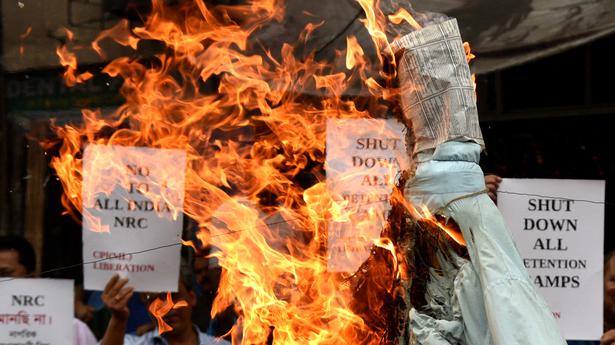
Explained | Why has the Manipur Assembly resolved to implement the NRC?
The Hindu
Which are the other northeastern States to undertake similar processes for separating indigenous communities from non-indigenous groups?
The story so far: On July 5, the 60-member Manipur Assembly resolved to implement the National Register of Citizens (NRC) and establish a State Population Commission (SPC). The approval to a couple of private member resolutions moved by Janata Dal (United) MLA, Khumukcham Joykishan came after more than two dozen organisations, most of them tribal, demanded an Assam-like NRC to protect the indigenous people from a perceived demographic invasion by “non-local residents”.
The northeastern States have been paranoid about “outsiders”, “foreigners” or “alien cultures” swamping out their numerically weaker indigenous communities. Manipur, home to three major ethnic groups, is no different.
These ethnic groups are the non-tribal Meitei people concentrated in the Imphal Valley, the central part of Manipur, and the tribal Naga and Kuki-Zomi groups mostly inhabiting the hills around. There has been a history of conflict among these three groups, but the NRC issue has seemingly put the Meiteis and the Nagas on the same page. They claim that an NRC is necessary because the political crisis in neighbouring Myanmar, triggered by the military coup in February 2021, has forced hundreds of people into the State from across its 398-km international border. A majority of those who fled or are fleeing belong to the Kuki-Chin communities, ethnically related to the Kuki-Zomi people in Manipur as well as the Mizos of Mizoram. In July, seven Manipur students’ organisations and 19 tribal and mixed groups — none of them representing the Kuki-Zomi people — submitted a memorandum to Prime Minister Narendra Modi and Home Minister Amit Shah demanding the implementation of NRC and the establishment of an SPC to “check and balance the population growth”. The State Assembly bowed to these demands and decided to go for NRC and SPC.
In December 2019, Manipur became the fourth northeastern State to be brought under the inner-line permit (ILP) system after Arunachal Pradesh, Mizoram and Nagaland. A temporary official travel document to allow inward travel of an Indian citizen into a protected area, the ILP is implemented under the British-era Bengal Eastern Frontier Regulation. But less than two years later, an umbrella organisation that spearheaded the ILP movement said the system was flawed and that Manipur needed a stronger and more effective mechanism for protecting indigenous populations. The pro-NRC organisations said Manipur did have a robust pass or permit system that regulated the entry and settlement of outsiders. But it was abolished by the then chief commissioner Himmat Singh in November 1950, a tad more than a year after Manipur’s merger with the Union of India. This, they said, led to the increase “beyond imagination” in the population of non-indigenous people.
They also recalled a movement in the 1980s for the detection and deportation of foreigners from Manipur, following which the State government had signed two agreements for using 1951 as the base year for identifying the non-residents and evicting them. In June this year, Nongthombam Biren Singh’s BJP-led government approved 1961 as the base year for identifying the “natives” for the purpose of ILP. Most groups are not happy with this cut-off year and insist on 1951 as the cut-off year for the NRC exercise.
According to data presented in the Manipur Assembly, the population growth rates in the hill districts of the State were 153.3% between 1971 and 2001 and 250.9% between 2001 and 2011 compared to the corresponding national growth rate of 87.67% and 120% respectively. In the case of the valley (Imphal and Jiribam, a small patch adjoining southern Assam’s Barak Valley) districts, the growth rate was 94.8% and 125.4% during these periods. The abnormal population growth rates of the hill districts point to a strong possibility of a huge influx of non-Indians. The situation is such that smaller indigenous communities may face extinction, necessitating a study and action, the House was told. This indicated the government had Myanmar nationals, primarily the Kukis, on its radar.
They are not the only communities to be viewed as demographic invaders. The pro-NRC groups have identified “Bangladeshis” and Muslims from Myanmar who have “occupied the constituency of Jiribam and scattered in the valley areas”, as well as Nepalis (Gurkhas) who have “risen in tremendous number”. The Kukis have termed the threat perception irrational. The Kuki Inpi, the apex body of the community, said an NRC implemented with 1961 or 1951 as the cut-off year will not succeed and would affect some Meiteis and Nagas too. The major worry for the Kukis are community members who had to relocate from Senapati, Tamenglong and Ukhrul districts after an alleged ethnic cleansing by Naga extremist groups.













